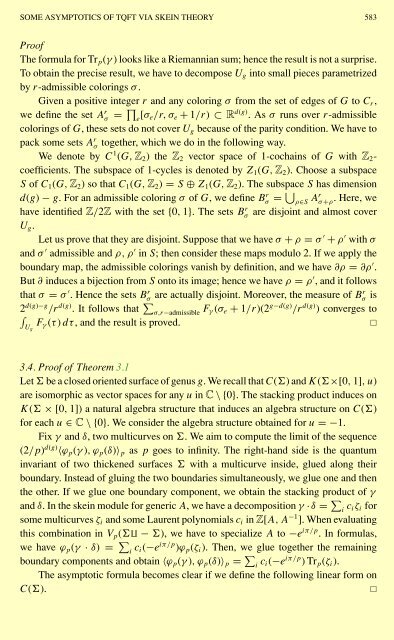A NULLSTELLENSATZ FOR AMOEBAS
A NULLSTELLENSATZ FOR AMOEBAS
A NULLSTELLENSATZ FOR AMOEBAS
You also want an ePaper? Increase the reach of your titles
YUMPU automatically turns print PDFs into web optimized ePapers that Google loves.
SOME ASYMPTOTICS OF TQFT VIA SKEIN THEORY 583<br />
Proof<br />
The formula for Tr p (γ ) looks like a Riemannian sum; hence the result is not a surprise.<br />
To obtain the precise result, we have to decompose U g into small pieces parametrized<br />
by r-admissible colorings σ .<br />
Given a positive integer r and any coloring σ from the set of edges of G to C r ,<br />
we define the set A r σ<br />
= ∏ e [σ e/r,σ e + 1/r) ⊂ R d(g) .Asσ runs over r-admissible<br />
colorings of G, these sets do not cover U g because of the parity condition. We have to<br />
pack some sets A r σ<br />
together, which we do in the following way.<br />
We denote by C 1 (G, Z 2 ) the Z 2 vector space of 1-cochains of G with Z 2 -<br />
coefficients. The subspace of 1-cycles is denoted by Z 1 (G, Z 2 ). Choose a subspace<br />
S of C 1 (G, Z 2 ) so that C 1 (G, Z 2 ) = S ⊕ Z 1 (G, Z 2 ). The subspace S has dimension<br />
d(g) − g. For an admissible coloring σ of G, wedefineBσ r = ⋃ ρ∈S Ar σ +ρ<br />
. Here, we<br />
have identified Z/2Z with the set {0, 1}. The sets Bσ r are disjoint and almost cover<br />
U g .<br />
Let us prove that they are disjoint. Suppose that we have σ + ρ = σ ′ + ρ ′ with σ<br />
and σ ′ admissible and ρ,ρ ′ in S; then consider these maps modulo 2. If we apply the<br />
boundary map, the admissible colorings vanish by definition, and we have ∂ρ = ∂ρ ′ .<br />
But ∂ induces a bijection from S onto its image; hence we have ρ = ρ ′ , and it follows<br />
that σ = σ ′ . Hence the sets Bσ r are actually disjoint. Moreover, the measure of Br σ is<br />
2 d(g)−g /r d(g) . It follows that ∑ ∫<br />
σ,r−admissible F γ (σ e + 1/r)(2 g−d(g) /r d(g) ) converges to<br />
U g<br />
F γ (τ) dτ, and the result is proved.<br />
<br />
3.4. Proof of Theorem 3.1<br />
Let be a closed oriented surface of genus g. We recall that C() and K(×[0, 1],u)<br />
are isomorphic as vector spaces for any u in C \{0}. The stacking product induces on<br />
K( × [0, 1]) a natural algebra structure that induces an algebra structure on C()<br />
for each u ∈ C \{0}. We consider the algebra structure obtained for u =−1.<br />
Fix γ and δ, two multicurves on . We aim to compute the limit of the sequence<br />
(2/p) d(g) 〈ϕ p (γ ),ϕ p (δ)〉 p as p goes to infinity. The right-hand side is the quantum<br />
invariant of two thickened surfaces with a multicurve inside, glued along their<br />
boundary. Instead of gluing the two boundaries simultaneously, we glue one and then<br />
the other. If we glue one boundary component, we obtain the stacking product of γ<br />
and δ. In the skein module for generic A, we have a decomposition γ · δ = ∑ i c iζ i for<br />
some multicurves ζ i and some Laurent polynomials c i in Z[A, A −1 ]. When evaluating<br />
this combination in V p (∐ − ), wehavetospecializeA to −e iπ/p . In formulas,<br />
we have ϕ p (γ · δ) = ∑ i c i(−e iπ/p )ϕ p (ζ i ). Then, we glue together the remaining<br />
boundary components and obtain 〈ϕ p (γ ),ϕ p (δ)〉 p = ∑ i c i(−e iπ/p )Tr p (ζ i ).<br />
The asymptotic formula becomes clear if we define the following linear form on<br />
C().
















